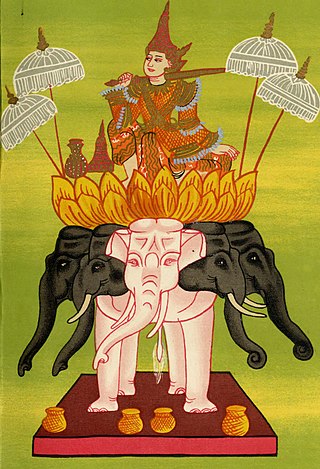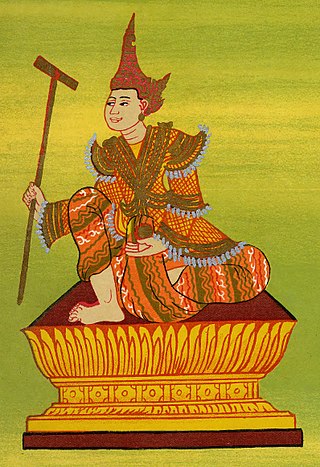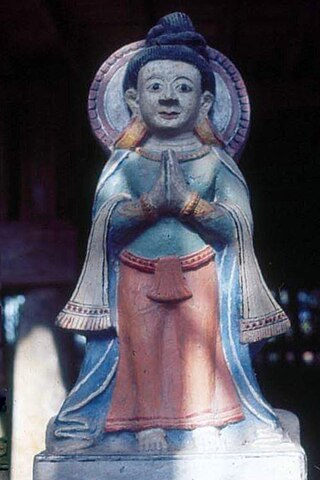Thihathu was a co-founder of the Myinsaing Kingdom, and the founder of the Pinya Kingdom in today's central Burma (Myanmar). Thihathu was the youngest and most ambitious of the three brothers that successfully defended central Burma from Mongol invasions in 1287 and in 1300–01. He and his brothers toppled the regime at Pagan in 1297, and co-ruled central Burma. After his eldest brother Athinkhaya's death in 1310, Thihathu pushed aside the middle brother Yazathingyan, and took over as the sole ruler of central Burma. His decision to designate his adopted son Uzana I heir-apparent caused his eldest biological son, Saw Yun to set up a rival power center in Sagaing in 1315. Although Saw Yun nominally remained loyal to his father, after Thihathu's death in 1325, the two houses of Myinsaing officially became rival kingdoms in central Burma.
Athinhkaya Saw Yun was the founder of the Sagaing Kingdom of Myanmar (Burma). The eldest son of King Thihathu set up a rival kingdom in 1315 after Thihathu appointed Uzana I as heir-apparent. Saw Yun successfully resisted two small expeditions by Pinya by 1317. While Saw Yun nominally remained loyal to his father, he was the de facto king of the area roughly corresponding to present-day Sagaing Region and northern Mandalay Region.
Uzana I of Pinya was king of Pinya from 1325 to 1340. Of Pagan royalty, Uzana inherited a disunited kingdom, which fell apart right after his predecessor Thihathu's death. Not only could he not retake the northern Sagaing Kingdom but he also had little control over his southern vassals. Even in his core power base in present-day central Myanmar (Burma), Uzana faced a serious rival in his half-brother Kyawswa. He ultimately lost the power struggle, and abdicated the throne in 1340 to a regent. He lived out his last years as a monk in Mekkhaya.

Kyawswa I of Pinya was king of Pinya from 1344 to 1350. His six-year reign briefly restored unity in southern Upper Burma although his authority over his southernmost vassals remained largely nominal. He suddenly died in 1350, and came to be regarded as one of the major Burmese folk spirits, known as Nga-zi Shin Nat.
Kyawswa II of Pinya was king of Pinya from 1350 to 1359. He had little effective control over his southern vassals but agreed to an alliance with Pinya's longtime rival Sagaing to face off the northern Shan state of Mong Mao. In 1358–59, while he tried to help Sagaing in the north, his home region of Kyaukse came under attack first by his erstwhile vassal Toungoo, and later by Mong Mao Shans. He died during the Shan raids.
Narathu of Pinya was king of Pinya from 1359 to 1364. He controlled only around the capital region, and unsuccessfully tried to stop the Mong Mao (Maw) Shan raids of Central Myanmar (Burma) that began in 1359. He reversed his predecessor Kyawswa II's policy of alliance with Sagaing, and later entered into an alliance with Mong Mao as a junior partner to dismember Sagaing. But the policy backfired when Mong Mao forces proceeded to sack Pinya in May 1364. He was brought back to the Shan country, and is remembered as Maw-Pa Min.
Uzana II of Pinya was king of Pinya for three months in 1364. He was merely a nominal king, and could not consolidate his power in the wake of the devastating raid by the northern Shan state of Mong Mao. He was overthrown in September 1364 by Thado Minbya of Sagaing.

The Pinya Kingdom, also known as the Vijaia State (၀ိဇယတိုင်း) and Kingdom of Pinya was the kingdom that ruled Central Myanmar (Burma) from 1313 to 1365. It was the successor state of Myinsaing, the polity that controlled much of Upper Burma between 1297 and 1313. Founded as the de jure successor state of the Pagan Empire by Thihathu, Pinya faced internal divisions from the start. The northern province of Sagaing led by Thihathu's eldest son Saw Yun successfully fought for autonomy in 1315−17, and formally seceded in 1325 after Thihathu's death.

The Sagaing Kingdom was a small kingdom ruled by a junior branch of the Myinsaing dynasty from 1315 to 1365. Originally the northern province of Sagaing of the Pinya Kingdom, it became de facto independent after Prince Saw Yun successfully fought for autonomy from his father King Thihathu in 1315–17. Sagaing formally seceded from Pinya in 1325 after Thihathu's death.
Mingyi Swa Saw Ke was king of Ava from 1367 to 1400. He reestablished central authority in Upper Myanmar (Burma) for the first time since the fall of the Pagan Empire in the 1280s. He essentially founded the Ava Kingdom that would dominate Upper Burma for the next two centuries.
Saw Omma was the chief queen consort of four consecutive kings of Pinya and Ava Kingdoms from 1350 to 1367. Descended from Pagan and Myinsaing–Pinya royal lines, the queen was well known for her beauty, and was selected as the chief queen of the last three kings of Pinya: Kyawswa II, Narathu and Uzana II. After the death of her fourth husband King Thado Minbya of Ava in 1367, she and her fifth husband Nga Nu unsuccessfully tried to seize the Ava throne. Her brother King Swa Saw Ke, who succeeded Thado Minbya, pardoned her but also married her off to the commander who captured her.
Pwa Saw was a chief queen consort of King Narathihapate of the Pagan Dynasty of Burma (Myanmar). She is remembered as witty, wise, and beautiful, and as someone who exercised political influence for four decades during one of the most difficult periods in the country's history. Historians are divided as to whether the chronicle narratives contain more myth than fact.
Saw Yan Naung was governor of Prome (Pyay) from c. 1344 to 1375 and viceroy of Prome from 1375 to 1377/78. Descended from Pagan and Pinya royalty, Saw Yan Naung was first appointed to the governorship by King Kyawswa I of Pinya. From 1367 onwards, the governor helped his brother King Swa Saw Ke of Ava consolidate the former southern vassals states of Pinya into Ava's fold.
Shwe Nan Shin was governor of Myinsaing in the mid-14th century. He was the eldest sibling of King Swa Saw Ke of Ava. He became governor of Myinsaing c. 1344 during the Pinya period. He was no longer governor of Myinsaing, certainly by 1390. He may have been succeeded at Myinsaing by his son-in-law Thettawshay.
Saw Pyei Chantha was the chief queen consort of Arakan for a few months in 1408. After she and her first husband King Anawrahta of Launggyet were captured by the Hanthawaddy forces in 1408, she became a junior queen consort of King Razadarit of Hanthawaddy.

Anawrahta Minsaw was king of Launggyet Arakan from 1406 to 1408. He was appointed to the position by his overlord King Minkhaung I of the Ava Kingdom. He later married Minkhaung's eldest daughter Saw Pyei Chantha. He was overthrown in 1408 by the Hanthawaddy Kingdom army, and subsequently executed on the order of King Razadarit of Hanthawaddy. He is one of two historical personalities that make up the Shwe Nawrahta nat spirit in the Burmese pantheon of nats.
Thray Sithu of Myinsaing was a Burmese royal who served as a senior minister at the court of Ava from 1400 to 1426. A grandson of two kings, the prince was governor of Myinsaing, the ancestral home of the Pinya–Sagaing–Ava dynasties, from c. 1386 to 1426. He was also Ava's wartime Viceroy of Arakan for a few months in 1408–1409.

Min Hti was king of Launggyet Arakan from c. 1279 to 1373/74. He is best known for being the longest reigning monarch in history, although the exact length of his reign is unknown. He became king at a young age after his father Min Bilu was assassinated by Sithabin I of Arakan. According to the Arakanese chronicles, he reigned for 106 years while one British colonial era scholar estimated it to be about 95 years. The Guinness Book of World Records, however, recognizes it as the longest "reputed" reign.

This is a list of orders of battle for the 1408–1410 campaigns of the Ava–Hanthawaddy War (1408–1418).




